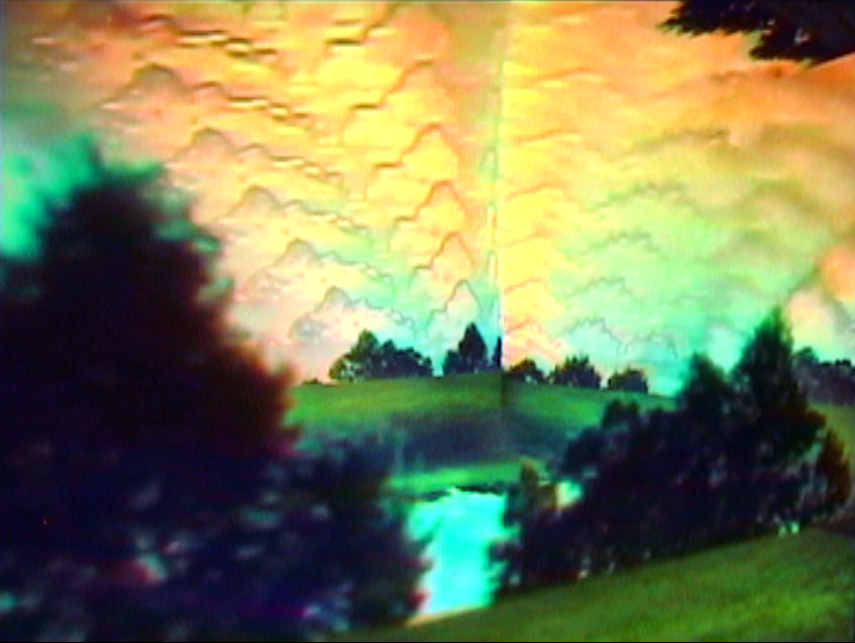“The sky above the port was the color of television, tuned to a dead channel.” – William Gibson Neuromancer
I was walking in Peckham (south London) last week, early evening, the sun had set an hour before, street lamps cast their orange glow onto the crumbling brick walls and wonky lanes of this old city. I thought about a world that is buzzing all the time around us, that is connected at points, but at times so completely unrelated breeding new worlds of its own within itself.
The week before in the same part of the city I had been to, Primo Aniversario, at The Sunday Painter gallery. This show was the first physical exhibition organized in celebration of the first anniversary of the online only London “based” gallery bubblebyte.org. Started in 2011 by Rhys Coren and Attillia Fatorri Franchini, the artworks at bubblebyte.org consist mainly of animated gifs, flash animations, and video works. (A flash animation created by Nicholas Sasson for the occasion of the Primo Anversario show can be found here.)
Currently on display at bubblebyte.org are six works by Paul Flannery. Flannery is one of a host of artists around the world whose work mines the abstract aesthetic potential of the decorations and stylistic conventions of the early internet (circa 1990). The work of Flannery et al, explores the anarchic beauty of poorly designed glittering websites anonymously posted on free hosting servers by amateur creators reveling in the freedom of a new found electronic wilderness.

Exhibitions at bubblebyte.org only stay up for a month, as they would in a classical exhibition space. When the show is done the work comes down, and all that’s left is an archived press release and a link to the artist’s website. bubblebyte.org fits somewhere inbetween the production of work in an infinitely archival digital format and the real life ephemerality of an exhibition. Conceptually a lot of internet based art turns on the subversion of the digital promise of infinite access to infinite material all the time. It points to the often clunky structures we have designed to achieve this and exploits the moments when things cease to function invisibly and reveal something of the nature of the medium of their creation.
A stand-out artist at bubblebyte.org’s real life Primo Aniversario exhibit last month was Montreal based video artist Sabrina Ratté’s work “Activated Memory I”(below). Ratté’s atmospheric looped videos exploit the unwanted by products of the miscommunication between different breeds of audiovisual equipment. Usually she isolates glitches and expands their aesthetic potential using feedback loops. She says she’s interested in the interaction between digital sound and image. Her videos are usually paired with an electronic soundtrack. Strongly reminiscent of early 80s computer animation and visual synthesis, her imagery is nonetheless undeniably contemporary.
Activated Memory I. Sabrina Ratté. 2011
Artists are generally assumed to be aware of the art historical precedents of what they’re up to and to engage with that history through their work. New media art by definition is a-historic, adopting non-artworld precedents of contemporary life, – the internet, digital imagery – and placing them in a gallery context. New media art is also inherently rooted in the medium of its creation and sets out to explore the limits and unique potential of a particular format or platform. The gallery context generates a problem: not only the difficulty of showing art that is so difficult to sell, commdify, or own (though I’m sure we’ll find a way around this one), but because of the difficulty of presentation.
Seeing this work out of context on monitors, or projected in a physical space changes it. The action of scrolling, the illusion of immersion a screen – and our focus on it – somehow generates, the promise of infinite content and the anarchic visual experience of the internet, these are unique to the perception of this artwork and to an extent necessary for their accurate display. Nonetheless actually attending an exhibition of this work does seem to sit in the physical memory a bit better than a quickly forgotten scroll through a website.
Retour des Étoiles. Sabrina Ratté. 2011.

